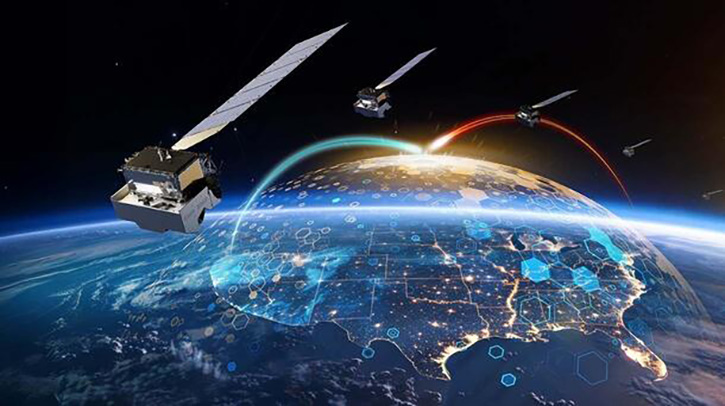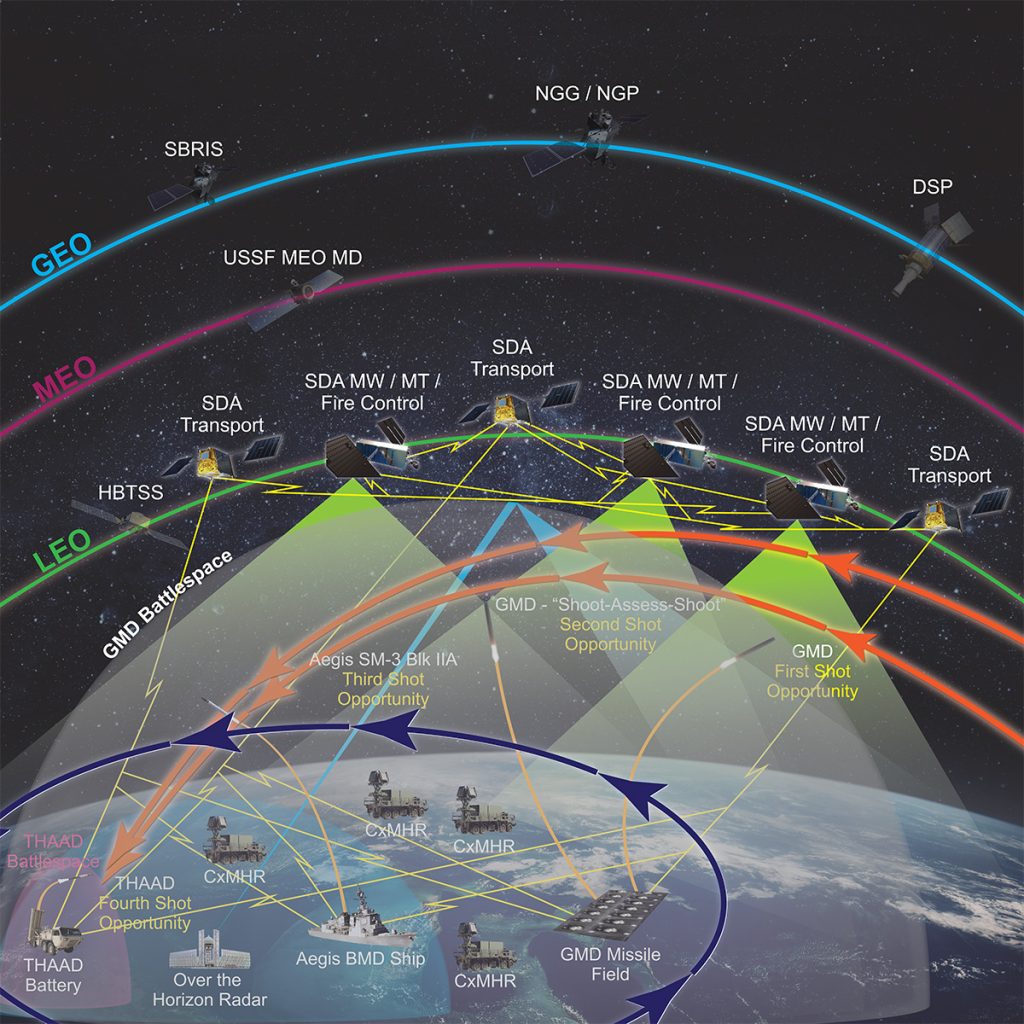
- Golden Dome for America is a powerful statement of the United States’ unwavering will to protect its country from growing international dangers, not only a missile defence.
- It is a strategy to create an advanced, multi-layered missile defence system that combines cutting-edge technologies with tried-and-true systems.
- The goal of the Golden Dome for America is to unite the most creative brains and boldest ideas from throughout the US military community in a project the size of the Manhattan Project.
- Golden Dome provides U.S. leaders with critical decision time during crises by integrating space-based sensors, AI-powered command systems (C2BMC), and sophisticated radar networks.
America faces increasingly complex and technologically sophisticated missile threats in a world security environment that is changing quickly. The nature of war has evolved, and the country’s defence must adapt as well. Examples include nuclear-tipped intercontinental ballistic missiles (ICBMs) for strategic attacks and hypersonic glide vehicles that can outmanoeuvre traditional monitoring systems. The Golden Dome for America is a ground-breaking concept that was developed to counter these threats and protect the country.
Golden Dome, the product of former President Donald J. Trump’s strategic vision, stands for the idea of achieving peace via force. It is a strategy to create an advanced, multi-layered missile defence system that combines cutting-edge technologies with tried-and-true systems. Its mission is to serve the American people with long-term security, deter enemy aggression with credible defensive power, and defend the continental United States with unwavering accuracy.
Golden Dome, a defender of vast swaths of territory, critical infrastructure, and human populations against a variety of airborne threats, follows in the footsteps of Israel’s Iron Dome, which transformed tactical missile defence in the Middle East. It is more than just a shield; it is a technological manifestation of strategic deterrence that maintains peace while projecting force.
The Imperative of Mission
The Problem
In its recently released, declassified research, “Golden Dome for America: Current and Future Missile Threats to the U.S. Homeland,” the Defence Intelligence Agency (DIA) draws attention to the major rivals’ fast-developing missile systems, which include those of China, Russia, North Korea, and Iran. These nations are presenting hitherto unheard-of difficulties for the protection of the American homeland since they are not only producing more missiles but also improving their speed, dexterity, and stealthiness.
The following are some of the more concerning trends:
- Nuclear payloads that can be delivered across continents by intercontinental ballistic missiles (ICBMs);
- SLBMs, or submarine-launched ballistic missiles, which are mobile and stealthy from underwater platforms;
- Hypersonic Glide Vehicles (HGVs) are aircraft that can manoeuvre while in the air and fly at speeds more than Mach 5, making them challenging to intercept.
- Land Attack Cruise Missiles (LACMs), which are harder to detect and cruise at low altitudes;
Additionally, Fractional Orbital Bombardment Systems (FOBS) can bypass traditional radar coverage by putting payloads into space before deorbiting them over targets.
Complex warhead delivery systems and agile reentry vehicles are examples of such new threats, which render traditional missile defence systems inadequate unless bolstered by sophisticated, multi-layered detection, tracking, and interception technology.
Evolving Missile Threat Landscape
Golden Dome: Design and Concept

The Perspective
The goal of the Golden Dome for America is to unite the most creative brains and boldest ideas from throughout the US military community in a project the size of the Manhattan Project. In addition to protecting American territory, it aims to modernise missile defence for the twenty-first century by constructing a multi-layered, flexible, and future-proof defence against all missile threats.
This ambitious project, which brings together emerging technology firms, space pioneers, government research organisations like DARPA and NASA, and well-known defence contractors like Lockheed Martin and Raytheon, is based on national unity and strategic need. The goal of the Golden Dome is to protect the nation with unmatched precision by combining defence expertise, artificial intelligence (AI) innovation, cyber strength, and space-based defence technologies.
With its global-operational Command and Control, Battle Management, and Communications (C2BMC) system, Lockheed Martin is a key integrator leading this effort. Under the Golden Dome, this system, which has previously been tested in combining global missile defence components, will be further developed and altered to incorporate sensors, radars, satellite feeds, artificial intelligence (AI)-based threat detection algorithms, and real-time interceptor systems.
Open Design and Modular Architecture
Golden Dome is known for its open architecture, which was designed to provide seamless interoperability and rapid integration. This design strategy ensures: Plug-and-play compatibility with new types of interceptors or detecting sensors.
- Improvements that are modular and don’t impact the entire system.
- Prediction and targeting modules based on AI/ML are added immediately.
- Commercial off-the-shelf (COTS) improvements can be easily integrated to save costs.
This system is not going to remain motionless. The Golden Dome is built to continuously improve as hostile systems’ technology advances, whether that means deploying orbiting sensor platforms, deploying hypersonic interceptors, or using quantum processing to analyse radar data.
Features of the Design
- Multiple tiers of multi-layered defence, ranging from high-speed ICBMs to low-flying cruise missiles.
- Integration of sensors and interceptors based on land, sea, air, and space.
- Advanced command centre architecture for threat assessment in almost real time.
- Reduced human reaction time with AI-enhanced decision-making.
- Cyber-resilience to stop system interference or takeover.
In addition to protecting the country, the Golden Dome will serve as a deterrent to potential enemies by combining these state-of-the-art technologies into a single, dynamic structure that communicates unbreakable resilience.
Range and Integration Effectiveness: The goal of the Golden Dome missile defence system is to defend the American homeland with a multi-layered, full-spectrum approach. In order to identify, monitor, and intercept missile threats entering U.S. territory at all stages of flight—boost, midcourse, and terminal—its architecture integrates assets from space, land, and the ocean.
Detection Based in Space: Early warning of launches, including hypersonic or fractional orbital attacks, is made possible by the near-global coverage provided by LEO and GEO satellites, such as SBIRS and the upcoming HBTSS.
Interception in the Midcourse: The Ground-Based Interceptor (GBI) and SM-3 Block IIA/IIB have successful ranges of 3,000 to 5,500 km, intercepting threats hundreds of kilometres from U.S. coasts to eliminate deep-range ballistic threats while they are in transit.
Defence of Terminals: THAAD and PAC-3 MSE systems provide 100–300 km of vital infrastructure and population regions with protection against medium- to close-range threats and end-stage interceptions.
Integration of AI and Sensor Fusion: Golden Dome sensor net uses the C2BMC (Command and Control, Battle Management, and Communications) network to integrate SBIRS, LRDR, Aegis SPY-6, AN/TPY-2, and HBTSS. This offers redundancy, layer handoff, and real-time threat tracking.

| Exercise Hypothesis: Operation Rising Shield |
|---|
| Date: 16 July 2029 Location: Seattle Defence, U.S. West Coast Sector Event: A renegade state’s exercise, Red Team Attack U.S. Space Command detects a suspicious launch from the North Pacific at 0200 hours. SBIRS confirms the trajectory of three hypersonic glide vehicles, five ICBMs, and two submarine-launched ballistic missiles (SLBMs) in a matter of seconds. Additionally, a sophisticated cruise missile is seen cruising low toward San Francisco Bay. The Reaction of Golden Dome Phase of detection: HBTSS and SBIRS keep an eye on the launches. HGVs are regarded as high-priority hazards by AI in C2BMC. Phase of tracking: Aegis SPY-6 on a Pacific destroyer tracks cruise missiles and SLBMs, while LRDR locks on ICBMs. Phase of Interception: – Three ICBMs are destroyed by GBIs in mid-course over the Pacific. – The terminal descent of SLBMs is engaged by THAAD. – A cruise missile is shot down over Central California by a PAC-3 MSE. – During atmospheric glide, one HGV is destroyed by the Directed Energy System (testbed). – As a result, every threat was eliminated. No casualties. National morale was raised. Improved deterrence. |
Golden Dome’s Strategic Significance
Deterrence Multiplied
Golden Dome’s multi-layered defence architecture is its greatest strength, guaranteeing that national security won’t be jeopardised by a single failure. Utilising established platforms like as GBIs, THAAD, PAC-3 MSE, and experimental directed energy systems, it offers interception capabilities at all stages of a missile’s flight, including the launch, midcourse, and terminal.
Golden Dome provides U.S. leaders with critical decision time during crises by integrating space-based sensors, AI-powered command systems (C2BMC), and sophisticated radar networks. This improves strategic stability and lessens the need for immediate retribution. By negating the impact of an unexpected first attack, it dissuades enemies and strengthens the legitimacy of America’s second-strike capabilities.
International Integration
In order to improve collective security, Golden Dome is designed to work with other systems. It will connect to Japan’s Aegis-based BMD network, NATO’s missile defence, and Israeli systems like Iron Dome for modelling urban defence.
Furthermore, unified threat neutralisation, coordinated actions, and smooth real-time intelligence exchange are made possible by integration with partner space and cyber networks. By preventing redundancy, projecting strength, and multiplying deterrence, this whole-of-alliance strategy makes sure that the United States and its allies stay ahead of missile threats from both state and non-state actors.
Realities and Risks
A dynamic ecosystem encompassing software integrity, electromagnetic resilience, cyber defence, and system interoperability under tremendous pressure, missile defence is significantly more complicated than interceptors and radar arrays.
- Important hazards: False Positives and Friendly Fire: In situations where the stakes are high, incorrectly identifying friendly assets or decoys could result in disastrous choices.
- Swarm attacks that use dozens of projectiles or decoys at once can overwhelm sensors and interception systems, causing system overload.
- EMP and Cyber Threats: Golden Dome’s AI, radar networks, and C2BMC—its digital backbone—must be protected from electromagnetic pulse (EMP) attacks and cyber breaches that could impair reaction capabilities.
- In order to lessen these, Golden Dome uses AI-enhanced decision-making, incorporates redundancy at every level, and implements robust, fail-safe systems that can function independently in compromised circumstances.
Conclusion
Golden Dome for America is a powerful statement of the United States’ unwavering will to protect its country from growing international dangers, not only a missile defence. America must respond with unmatched creativity and urgency as adversaries enhance their weapons with hypersonic and advanced ICBMs.
Golden Dome is a national endeavour led by Lockheed Martin and supported by a group of leading defence and technology partners. It combines cutting-edge sensors, artificial intelligence, and proven interceptors into a multi-layered defence system. It offers global integration, rapid reaction, and strategic depth. Last but not least, Golden Dome offers peace through strength in addition to deterrence by capability, bolstering national security while reassuring allies and discouraging adversaries with a clear, believable, and strong defence framework.
References:
- https://www.dia.mil
- https://www.mda.mil
- https://www.lockheedmartin.com/en-us/news/features/2025/golden-dome.html
- https://www.lockheedmartin.com/en-us/products/c2bmc.html
- https://www.ft.com/content/84168739-c343-416a-adb8-1e046dad6c95
- https://www.businessinsider.com/trump-golden-dome-ukraine-drone-attacks-2025-6
- https://www.reuters.com/business/aerospace-defense/trump-asked-japan-help-with-golden-dome-missile-shield-nikkei-reports-2025-06-03
- https://www.defenseone.com
Piyush Anand is a Biotechnology Engineering student at Chandigarh University. His primary interest lies in International Affairs, Defence and Strategy. Views expressed are the author’s own.
